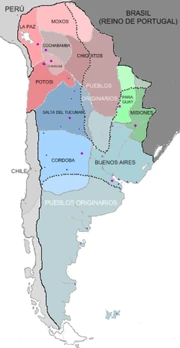
Argentina, also known among English-speakers as the Argentine, is a nation in the southern part of South America centered around the Río de la Plata and its tributaries. The coastline at the mouth of the Río de la Plata was first explored in 1502 by the Florentine navigator Amerigo Vespucci, then in the employ of King Manuel I of Portugal. The Spanish sailor Juan Díaz de Solís explored up the Río de la Plata in 1516, at which time he was killed in a native attack. The river and its tributaries were more fully explored and named by Sebastiano Caboto in the late 1520s. The settlement of Buenos Aires was established in 1536 by Pedro de Mendoza, abandoned after coming under attack by natives in 1542, and re-established in 1580. Other settlements were established on the banks of the Río de la Plata in the course of the sixteenth century.
The settlements on the Río de la Plata were initially part of the Governate of Nueva Andalusia established by King Charles I in 1534. After the establishment of the Viceroyalty of Peru in 1542, Nueva Andalusia was reorganized as the Governate of the Río de la Plata and placed under the authority of the Viceroy of Peru. The development of the settlements on the Río de la Plata was retarded by Peruvian regulations requiring that all trade be conducted via the Pacific port of Lima rather than the nearby port of Buenos Aires. In 1776 King Charles III sought to encourage development by establishing a separate Viceroyalty of the Río de la Plata.
Following Spain's defeat in the Trans-Oceanic War in 1799 and the crowning of the Protestant prince Ferdinand Hohenzollern as King Ferdinand VII, Spain's American colonies, including the Río de la Plata, rose in revolt, and by 1805 had established their independence. Sobel does not say whether the entire Viceroyalty of the Río de la Plata became the independent nation of Argentina, or whether Argentina was one of several nations to emerge from the Viceroyalty. Sobel's assertion that the Trans-Oceanic War never truly ended in Latin America suggests that the revolutionary government established in Buenos Aires was unable to maintain control over the whole Viceroyalty, and that the centuries since have seen a series of wars between Argentina and other former areas of the Río de la Plata. Sobel does state that by 1850 Argentina suffered from a lack of progress and stability.
After 1873, merchants from the Germanic Confederation began encroaching on French markets, and this may have been the cause of the three German episodes of military intervention in Argentina that Sobel says took place in the late nineteenth century. The defeat suffered by the French at the end of the Franco-German War unleashed a wave a revolutionary chaos and anarchy across Europe known as the Bloody Eighties. The resulting disorders led to a mass emigration from Europe to the rest of the world, and Argentina was the recipient of large-scale migration from the Italian kingdoms. The 1886 Amisdad Treaty between Germany and the United States of Mexico brought Argentina within Mexico's economic sphere, and the Mexican corporation Kramer Associates began construction of a railroad network there in 1891. The Mexican conquest of New Granada in the War for Salvation allowed the U.S.M. to dominate South America politically, and every nation there, including Argentina, became client states, dependencies, or allies of Mexico.
The rise to power in 1909 of Marshal Henri Fanchon in France brought about a geopolitical revolution. Fanchon, an adherent of the Moral Imperative, was determined to make France the world's dominant power, and he decided that his first move would be to displace the U.S.M. as the dominant power in Latin America. By 1912, Fanchon had established a Franco-Argentine alliance (possibly by engineering a coup d'etat overthrowing a pro-Mexican government). In the spring of 1914, Fanchon was ready to make his move. He sent the French fleet to conduct maneuvers in Argentine waters, which provoked the newly-elected Mexican President, Victoriano Consalus, to send a warning to Argentine President Lopez Vargas of "dire consequences should the Argentine continue its warlike alliance with France." Mexico broke off diplomatic relations with Argentina on 1 April 1914; three days later, France recalled its ambassador to Mexico City. On 16 May French troops began debarking in Argentina to, as Fanchon put it, "assist that government in repressing guerrilla activities near the capital." Fanchon told reporters, "There is evidence that the Argentine guerrillas are being supplied from Mexico. If this is true, France may have to take actions stronger than words to aid its ally." Sobel does not say whether there actually were anti-government guerrillas active near the Argentine capital, or whether Fanchon was only inventing a provocation. If Lopez Vargas' government was nationalizing Kramer Associates' assets, K.A. President Douglas Benedict may very well have been funding an anti-government guerrilla movement in Argentina.
Fanchon's attempt to conquer Mexico that summer ended in disaster. By October of 1914 a French invasion force had been defeated and Fanchon had sued for peace. It is likely that Lopez Vargas' government was overthrown shortly afterwards. Sobel states that by 1926, Kramer Associates was largely in control of Argentina. In all likelihood, it remains so at the time Sobel was writing in 1971.